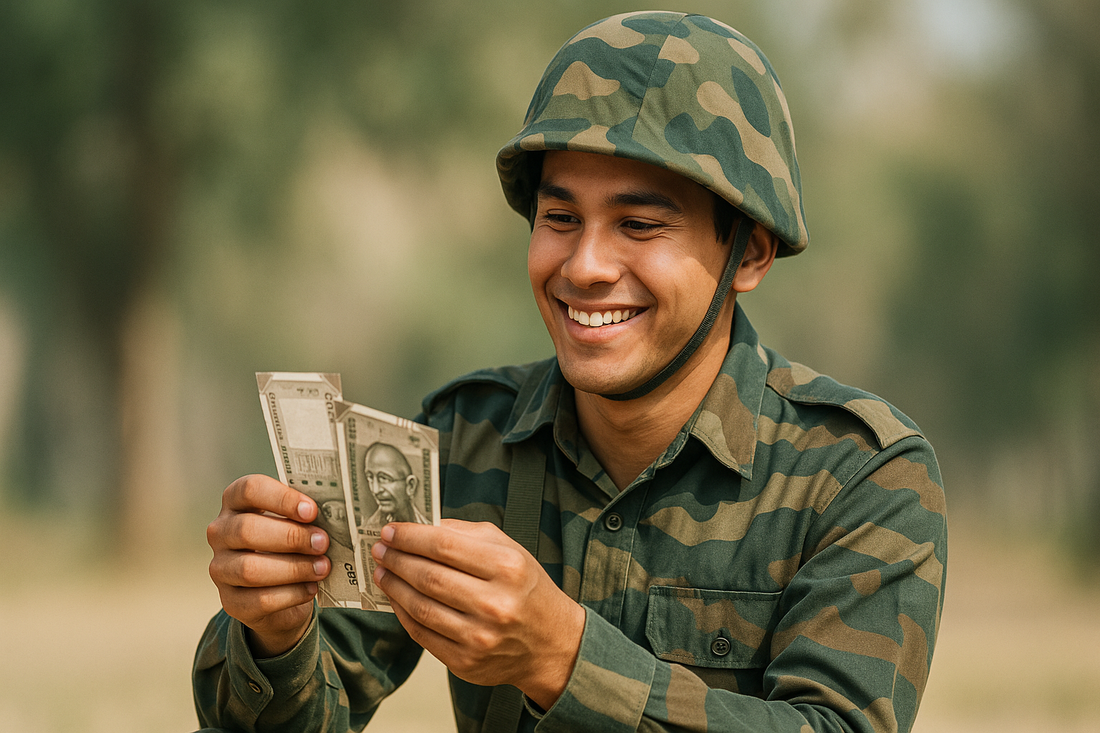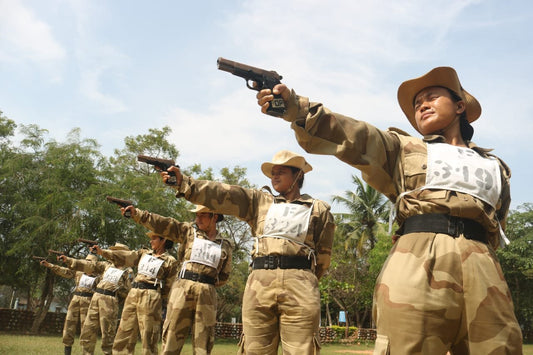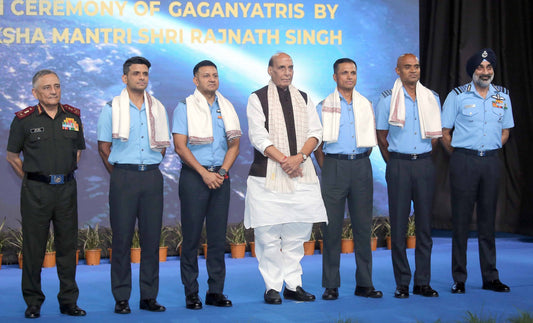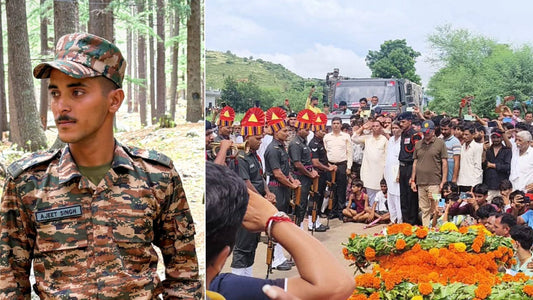How Much Indian Army Soldier Earns Per Month?

The Indian Army, an esteemed pillar of national defence, attracts countless young men and women who wish to serve their country with honour and courage. Beyond the valor associated with military service, one crucial aspect that prospective recruits often consider is compensation: "How much does an Indian Army soldier earn per month?" Understanding this financial reality not only provides insight into the life of a soldier, but it also sheds light on the complexities of military pay structures, rewards, and associated benefits.
Historical Context of Indian Army Soldier Pay
The salary structure for the Indian Army has evolved significantly over the years, mirroring changes in societal norms, inflation rates, and government policies. Historically, military personnel were not always adequately compensated for their service, leading to demands for better pay.
The introduction of the Pay Commissions starting with the Fourth Pay Commission and culminating in the recent Seventh Pay Commission has played a crucial role in restructuring and revamping the pay scales for soldiers. Each iteration aimed to acknowledge the vital role of the armed forces while ensuring that their remuneration was equitable compared to other sectors.
Understanding the Pay Structure
Basic Pay for an Indian Army Soldier
At the foundational level, an Indian Army soldier, commonly referred to as a Sepoy, receives a basic salary that falls within the range of ₹21,700 to ₹30,000 per month, as per various sources evaluating the current pay matrix under the 7th Pay Commission.
The nuances of pay can vary across ranks, experience, and even geographical postings. Here are the specified basic pay ranges for various ranks:
| Rank | Basic Pay (₹/month) |
|---|---|
| Sepoy | ₹21,700 – ₹30,000 |
| Lance Naik | ₹21,700 – ₹40,000 |
| Naik | ₹25,500 – ₹40,000+ |
| Havildar | ₹29,200 – ₹45,000+ |
| Naib Subedar | ₹35,400 – ₹50,000+ |
| Subedar | ₹44,900 – ₹60,000+ |
| Junior Commissioned Officers (JCOs) | Up to approximately ₹65,000 |
As the ranks progress from Sepoy to more senior positions, one can observe a systematic increase in basic pay, reflecting both responsibility and experience.
Additional Allowances
In addition to basic pay, soldiers receive a variety of allowances designed to ensure their financial stability, adaptability, and welfare. These include:
- House Rent Allowance (HRA): Depending on the posting, soldiers receive HRA when they are not provided with government accommodation.
- Transport Allowance: This is provided to aid with travel expenses.
- Risk and Hardship Allowances: These are essential given the nature of military duties, particularly in postings in conflict zones or remote areas.
- Field Area Allowance: Additional pay that soldiers receive for serving in difficult or uninhabitable areas.
Cumulatively, these allowances can significantly boost the total monthly earnings of a soldier, raising it well beyond their basic pay.
Junior Commissioned Officers (JCOs) and Other Ranks
As soldiers ascend the ranks to Junior Commissioned Officers (JCOs) such as Naib Subedar and Subedar the basic pay continues to increase. For instance, a Naib Subedar might receive around ₹35,400 to ₹50,000, while a Subedar can earn approximately ₹44,900 to ₹60,000 per month.
Such structured increments are vital in motivating personnel to aim for higher ranks, reinforcing the system of meritocracy within the military hierarchy. Additionally, for officers beginning their career as a Lieutenant, the monthly pay starts around ₹56,100 and can escalate to figures surpassing ₹2,50,000 for the Chief of Army Staff. These disparities highlight the different responsibilities and strategic importance associated with each rank.
Agniveer Salary – A New Entry Level
In a significant administrative reform, the Defence Ministry introduced the Agniveer programme, targeting a younger demographic to join the forces on a short-term contractual pathway.
The starting salary for an Agniveer is pegged at ₹30,000 per month, with annual increments and various allowances. This innovative model aims not only to bolster troop strength but also to provide a unique career opportunity for young men and women.
Additional Benefits Beyond Salary
It is essential to note that a soldier's compensation package extends beyond just salary and allowances. Beneficiaries of military service enjoy numerous advantages that enhance their overall quality of life:
- Pension and Retirement Benefits: Soldiers can look forward to lifelong pension plans after a sufficient period of service, ensuring financial security during retirement.
- Medical Facilities: Comprehensive healthcare is provided free of cost for soldiers and their immediate families, ensuring peace of mind with regards to medical expenditures.
- Canteen Facilities: Armed forces personnel enjoy subsidised rates for essential goods through Army Canteens, allowing them to save significantly on daily purchases.
- Career Progression Opportunities: The military offers numerous avenues for growth, including specialized training, courses, and promotions based on performance, providing a clear pathway for skill enhancement and career advancement.
Statistical Data and Insights
Analyzing soldiers' salaries reveals broader implications about financial growth in India’s Defence sector. As per the Government of India's expenditure guidelines, military salaries consume a relatively small percentage of the overall defence budget.
For the financial year 2022-23, the Indian Defence budget allocated ₹5.25 lakh crore for various expenditures, of which salaries make a significant, but controlled chunk, ensuring a balance is maintained. Moreover, the implementation of the Seventh Pay Commission has been a blessing for serving members.
Based on the latest reports (2025), approximately 400,000 soldiers benefited directly from the revisions in pay scales, transforming how soldier compensation structures are perceived not only in India but also globally.
Comparative Analysis
When comparing the Indian Army's pay structure against other volunteer militaries and paramilitary forces globally, it is crucial to account for local economic factors and living standards. For instance, while Indian soldiers command a respectable pay and benefits package relative to other professions in India, the monetary compensation is often lower when juxtaposed with the earnings of defense personnel in developed countries like the United States, where salaries can start at over $50,000 annually (approximately ₹40,00,000). Nonetheless, the additional benefits, robust pension schemes, and comprehensive healthcare reflect a more holistic view of compensation and reinforce why many still choose to pledge their allegiance to the Armed Forces despite alternatives.
Challenges and Solutions
Despite the well-rounded remuneration systems, certain underlying challenges persist:
- Rising Inflation: Soldiers and their families often express concerns about inflation outpacing salary increases. - Potential Solution: Regular pay reviews and adjustments under the Pay Commission system can ensure alignment with inflation rates, securing purchasing power for soldiers.
- Public Perception and Awareness: Many civilians are unaware of the challenges and sacrifices faced by soldiers. - Potential Solution: Increased outreach and educational campaigns can highlight the value of military service and the overall conditions, fostering a better understanding and appreciation.
- Retention Issues: With the introduction of contractual roles like Agniveers, retention of experienced personnel becomes challenging. - Potential Solution: Developing retention strategies such as post-service job placements and higher incentives for long-term service can help maintain a robust and experienced military staff.
Future Trends and Predictions
As India continues to modernize its military, several trends may emerge that will influence soldier compensation and the overall compensation matrix: -
- Technological Integration: With the integration of technology into military operations, roles are becoming more specialized, potentially leading to higher pay for tech-savvy soldiers. -
- Global Collaboration: As Indian forces collaborate more closely with international counterparts, they may adopt more competitive compensation structures, enhancing recruitment and retention. -
- Policy Changes: Future legislative changes regarding military pensions and salary scales can be anticipated as societal views on military service evolve.
Conclusion
In conclusion, a soldier's earnings in the Indian Army typically ranging from ₹21,700 to ₹30,000 per month encompass a complex matrix influenced by rank, time served, allowances, and an admirable set of additional benefits. While numbers and policies illuminate the operating framework, it is the stories of dedication, sacrifice, and aspirations that forge the true essence of military life.
As India evolves, so too will its defence forces, ensuring that those who partner with valor in service to the nation are compensated adequately and comprehensively. Emphasizing the importance of understanding these figures will not only enhance public appreciation for the forces but also instill pride in those who serve proudly, knowing that their bravery is duly recognized and compensated.
For many, the call to serve transcends financial motivation, standing as a testament to enduring commitment to the nation and its people.




















13 comments
I retired from Army 23 years back and I can confidently say that Army persons (all ranks.. Sepoy to General) are still getting less pay and allowances compared to civil Government employees of equal status and employees in private companies. This is the reason for a big shortage of officers in Army, Navy and Airforce. A large number also take premature discharge/retirement even though they join with lot of enthusiasm. Most important aspect is Defence people are ON DUTY 24 hours and Round the Year. They respond immediately even in midnight when needed. They do their job continuously without bothering for Food and Rest if required. Anyone making adverse comments about Defence people should go and stay for a week in Siachen Or in Terrorism affected areas and then only they can realize the condition of life there.
Less pay compare to other countries
Less respect compare to other countries
Less welfare schemes for soldiers and only papers. Example GRANT OF AGRICULTURAL LANDS TO EXSERVICEMEN IS ZERO PERCENTAGE.
ALL RECRUITMENT GOES WASTE DUE TO GOVERNMENTS OFFICERS TO RESERVE LESS
KENDRIYA SAINIK BOARD MOT APPLYING ITS MIND GET JOBS TO DEPENDANTS WITH LOT OF CONDITIONS WHICH IS NOT REQUIRED
TOTALLY WELFARE SCHEMES ARE NIT REACHING CM AND PM NOT HELPING ONLY ON PAPER AND MEDIA
REQUEST GENUINELY TO POOR EXSERVICEMEN
6354 984 874
@Miss DURGA ……I understand your frustration, but your comment is riddled with inaccuracies and unfair generalizations that need to be addressed. Let’s set the record straight with facts, not baseless rants. Your claim about working in the Ministry of Defence doesn’t give you a free pass to spread misinformation or insult the dedication of defence personnel. It’s disappointing that someone in your position would resort to such a petty, uninformed outburst.
First, your assertion that defence salaries are the highest in India and tax-free is flat-out wrong. Indian Army salaries are governed by the 7th Pay Commission, with basic pay ranging from ₹21,700 for a Sepoy to ₹2,50,000 for the Chief of Army Staff. After allowances like Dearness Allowance (DA), House Rent Allowance (HRA), and Military Service Pay (MSP), a Sepoy’s in-hand salary is approximately ₹25,000–₹40,000 per month, not ₹50,000–₹60,000 as you claim. Officers start higher, with a Lieutenant earning around ₹68,000–₹75,000. These figures are comparable to other government sectors like IAS or IPS, not vastly superior as you suggest. Moreover, certain allowances like Field Area or Siachen Allowance are tax-exempt, but the basic pay and other components are subject to income tax, just like any other profession. Your claim of “no tax” is a lazy exaggeration.
Second, your jab at defence personnel being “uneducated and without brains” is not just insulting but embarrassingly ignorant. Entry into the Indian Army, even at the soldier level, requires passing rigorous physical, medical, and written tests. Officers undergo highly competitive exams like NDA or CDS, followed by intensive training at prestigious institutions like the Indian Military Academy. Many possess graduate or postgraduate degrees, and their training instills strategic thinking, leadership, and discipline—qualities that rival any “educated” professional. To call them uneducated while sitting behind a desk shows a pathetic lack of understanding about the demands of military service.
As for leaves, your claim about “the highest number of leaves” is another distortion. Army personnel are entitled to 20 days of casual leave and 60 days of annual leave, with up to 300 days of encashable leave over their career. This is comparable to other government employees, but unlike desk jobs, soldiers often serve in extreme conditions—think Siachen at -50°C or insurgency-prone areas—where leave is a necessity, not a luxury. Comparing their leave to civilian jobs without context is intellectually dishonest.
Your accusation that they “don’t deserve” their pay reeks of arrogance and ignores the reality of their sacrifices. Defence personnel risk their lives, endure long separations from family, and operate in high-stress environments. Their allowances—like ₹42,500 for Siachen or ₹9,000 for Special Forces—reflect the unique risks and hardships, not some undeserved perk. Meanwhile, your comment about them hiding salaries for “compassion” is baseless speculation, not a fact.
Finally, your blanket statement about their “ego” is a cheap stereotype. If anyone’s displaying ego here, it’s you, throwing around insults without evidence while claiming insider knowledge. It’s ironic that you call others uneducated when your comment is a masterclass in ignorance and prejudice. Next time, do some research before embarrassing yourself with such a tirade. The Indian Army’s personnel deserve respect for their service, not your misguided vitriol.
All these people who are speaking should first go and see the salary they get. I mean a 8th pass or 10th pass receives approx. 50,000 Rs. non taxable right after training with numerous other benefits and 90 days of leaves. They don’t deserve this much. Those brainless people are getting much more than they deserve. So, stop complaining.